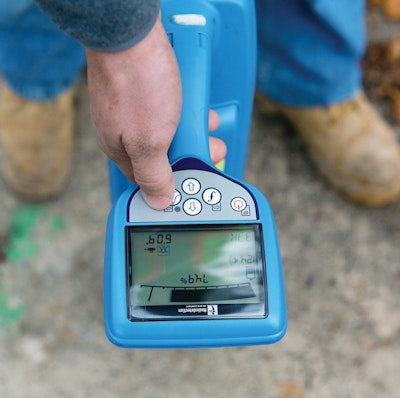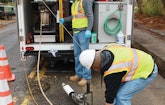Interested in Location/Detection?
Get Location/Detection articles, news and videos right in your inbox! Sign up now.
Location/Detection + Get AlertsThe Metropolitan Sewer District of Greater Cincinnati (Ohio) and Duke Energy have formed a unique partnership that helps them carry out pipeline inspections in ways that are efficient, cost-effective, and mutually beneficial.
Duke Energy has an ongoing effort to replace aging gas lines, and in doing so, it must avoid boring any new lines through sanitary and storm sewer mains and laterals. Meanwhile, MSDGC routinely inspects its sewer system and needs high-quality data on the condition and location of its buried assets.
To serve their needs, the two organizations have combined resources, using specified inspections contractors, sharing data, and splitting duties that often had been duplicated. Through partnership on a streamlined work plan, MSDGC gets enhanced information about its system, and the gas company completes its projects faster, more efficiently, and safely. Both entities can control costs and make sure contractors do quality work.
Finding common goals
Duke Energy is in the tenth year of a 16-year program to replace 70 to 85 miles of gas mains annually. As part of each project, the company has its contractors perform pre- and post-rehabilitation CCTV inspections of nearby sanitary and storm sewer lines to ensure that they have not been penetrated by gas lines. The company then provides the survey data to MSDGC for review.
District personnel saw an opportunity to combine efforts on inspections and other data collection — so long as video footage was compatible with the district’s needs. “It was a question of economy of scale,” says Jerome Weimer, wastewater collection supervisor for MSDGC. “We have expertise in televising, tracking and reviewing CCTV inspections of the sewers, while Duke has expertise in trenchless installation and in checking for breaches in the sewers with the gas lines.
“We both had the same goals of serving our customers reliably and in the safest way possible. By having each side focus on its core specialty and share knowledge and data, we could both get what we wanted to achieve for our individual systems.”
Supervisors from both agencies met numerous times, and it took about a year for them to set final procedures and begin working together.
Setting standards
The two agencies set physical and financial responsibilities based on making the best use of each party’s skills. MSDGC has several pipe inspection units assigned to routine maintenance work and emergency response, and those teams have kept that focus.
For work involving the partnership, inspection contractors are hired. Any contractor needs to be acceptable to MSDGC and Duke Energy, must meet specific criteria, and must accept a negotiated set of prices, terms and conditions for specific services performed.
Gas line installers are allowed to do their own CCTV inspections if they are qualified. In many cases, qualified contractors were already on both agencies’ approved lists.
At a minimum, all inspection contractors must have two years’ experience. They must have mainline inspection and lateral-launching equipment as well as pushrod cameras for house lateral inspections and electronic locating equipment. Their pipe survey software and inspection operators must be certified under the NASSCO Pipeline Assessment and Certification Program (PACP).
“Because we established the standards and unit pricing for the camera inspections, the contractors were able to focus solely on the service,” says Weimer. “A gas line installer who isn’t happy with the service received from an inspection contractor can call the district and request a different provider. If they need additional camera inspection resources, they can make a similar call to the district or Duke and another qualified company from the list will be assigned to assist with the camera inspections.”
Capturing to collaborate
For each gas line replacement project, Duke Energy must complete a series of data acquisitions before and after construction. In the pre-construction phase, the Duke Energy contractor must inspect all sanitary and storm sewer mainlines, manholes and laterals all the way to the right-of-way or the construction limits.
Construction limits apply where the gas line or gas service line has been installed by trenchless technology beyond the road right-of-way. In those cases, the inspection of any neighboring assets must go physically beyond where the gas line is laid to prove that it has not breached the sewer or any other wastewater collection system assets.
Before construction, all utility assets must be electronically located, and depths must be indicated on the survey and physically marked on the street. The pre-inspection phase is used to identify any problems in the sewer assets that might affect installation of the new gas line, and to pinpoint the location of all buried sewer facilities.
If any obstructions such as break-in taps are located during the video inspection, the contractor takes a snapshot using the pipe survey software and provides the image to MSDGC for review. The contractor is presumed to have permission to do what is needed to remove the obstruction.
The pre-installation data is submitted to MSDGC’s Engineering Department for review and approval. The inspection data and location coordinates are imported into MSDGC’s CCTV database through the PipeTech Access Portal from Peninsular Technologies, and is updated in the Cincinnati Area Geographic Information System (CAGIS) program on ArcView by Esri.
Once the replacement project is installed, an inspection crew must perform a post-installation survey before energizing the system, using NASSCO PACP and Lateral Assessment and Certification Program (LACP) standards.
As in pre-construction, all assets must be inspected to the right-of-way or construction limits. The demanding requirements of the post-inspection make it essential for approved contractors to have the right tools.
“Having standards established for the contractors was vital, as this project had some special requirements, such as providing all surveys in MPEG1 format, providing mainline and lateral inspections as separate files, and locating utility assets precisely,” says Tim Plurien, assistant operations manager for RLA Utilities, an approved contractor for Duke Energy gas line installations and MSDGC inspection and cleaning. “Knowing this, we could be fully prepared with the most effective tools to get the job done.”
RLA uses RD7000 locators from Radiodetection for electronic locating and reporting and PipeLogix software for pipe survey data collection. “The lateral module within PipeLogix has been very helpful for this project because of its ability to create separate clips during the mainline inspection,” Plurien says. “That eliminates the need for us to inspect twice to provide MSDGC and Duke Energy with the separate video surveys they require. We can generate both files off a single inspection run, making things much more streamlined and efficient for our crews.”
Once the final inspections are submitted and no issues are found, an affidavit is generated for Duke Energy, indicating that no breaches have occurred with any MSDGC assets, and that the project can be considered successfully installed.
Data payoff
The collaboration has expanded Duke Energy’s recordkeeping capabilities. “One of the biggest advantages of our agreement with MSDGC is recordkeeping — they’re specialists in stored information,” says Dan Schuler, senior engineering technician for Duke Energy. “All the information we capture during the inspection and location phases is now implemented into their mapping system.
“This benefits Duke in cases when a customer is experiencing a problem. We can call MSDGC and have videos checked if nearby utilities have been inspected recently. We can then determine the condition of those assets and whether the work we may have to perform will have an impact.”
Meanwhile, MSDGC benefits from expanding the type and amount of data collected in Duke Energy’s pre- and post-construction inspections. As a result, the database of information about the sewer system is becoming more comprehensive, at a faster pace and much more economically than if MSDGC relied on its own planned maintenance and annual inspection programs.
This is especially important in lateral locations. Now, when crews respond to a sewer backup or related issue, they have exact information about a given lateral, such as its precise location, any issues with the pipe, and its last inspection. That helps them resolve the issue efficiently and minimize disruption to the property owner.
Fine-tuning
No partnership is perfect, and the biggest challenge for MSDGC and Duke Energy related to administration rather than field work: Invoicing requirements for the agencies differed. For MSDGC, information is sorted and based on sewer segment identifiers, whereas for Duke Energy it is based on address. Going forward, contractors will receive a simple spreadsheet that cross-references both sets of information, so that each entity receives the information it needs to process invoices correctly.
Schuler and Weimer consider this accounting issue a small challenge. The partnership has gone better than anticipated, and both attribute the successful collaboration to three things: communication, communication and communication.
“We included in our year of planning the camera contractors, the installation contractors, the surveyors, Duke Energy and MSDGC employees — all of them in a number of types of meetings: big groups, small groups and individually,” says Weimer. “We got their input, their ideas and their feedback.”
Schuler adds, “Every time we have a large project, we have pre-construction meetings, inviting everyone involved so that everyone is in the loop from the very beginning. Getting and keeping everyone involved and engaged is what makes this work so smoothly.”
MSDGC and Duke Energy are grateful for the start of a beautiful friendship and look forward to more years of cooperation.










